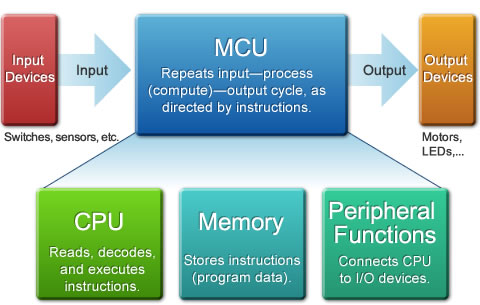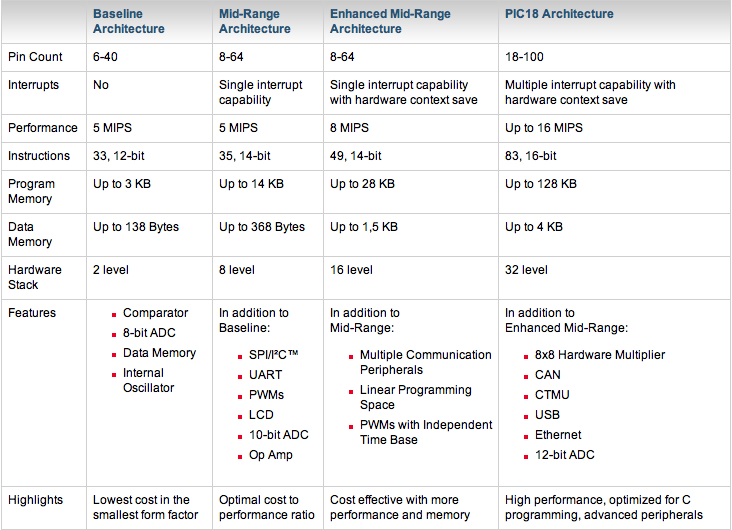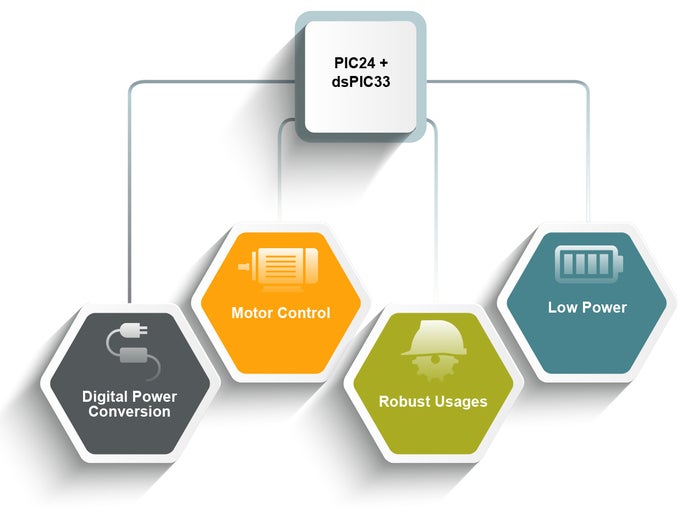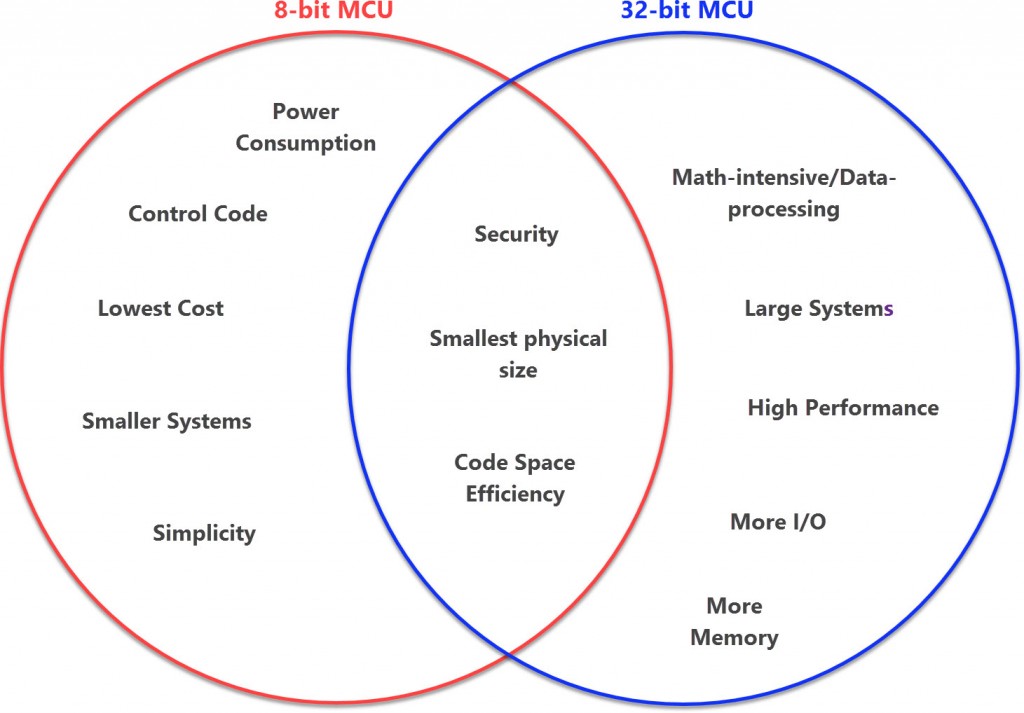Are more bits in an MCU better?
Source: InternetPublisher:风向西瓜 Keywords: mcu 32 bit 16 bit 8 bit Updated: 2025/02/07
Are more bits in an MCU better? This is similar to asking: Are more cylinders in an internal combustion engine (ICE) better? Peripherals and other features are important, not just bits. For MCUs, total power consumption, availability of peripherals, latency requirements, and other factors are important, not just the number of bits.
MCUs are everywhere. They are in cell phones, toys, vehicles, white goods, renewable energy systems, Internet of Things (IoT) devices, and more. MCUs are essential for controlling hardware functions from motors to blinking LEDs. The basic architecture of an MCU consists of a central processing unit, some memory, and peripheral functions (Figure 1). The MCU takes inputs from sensors, switches, and other devices and controls the functions of peripheral devices, such as displays, actuators, and drivers for motors, as dictated by preprogrammed instructions. Depending on the complexity of the functions being controlled and the amount of processing required for the various inputs, MCUs are available in 8-bit, 16-bit, and 32-bit options. Generally speaking, the more bits, the greater the processing potential.

A “bit” is a “binary digit.” In an 8-bit MCU, data is stored in groups of 8 bits, called bytes (or in some cases, octets). An 8-bit memory register can store one of a possible 28 values. The actual range of values varies depending on the integer representation used. For example, for unsigned binary numbers, the range is 0 to 255 (2^8 minus 1), and using two’s complement representation, the range is -128 (-1X2^7) to 127 (2^7–1). While the data bus in an 8-bit MCU is 8 bits wide, the width of the address bus can vary. Address bus widths of 12 to 16 bits are common. For example, a 16-bit wide address bus would yield 65,536 (2^16) bytes (called 64KB). But these classifications only begin to hint at the actual capabilities of a particular 8-bit MCU (Figure 2).

8-bit MCUs are widely used; they offer simple programming, energy efficiency, and small package sizes (some have only six pins). However, these MCUs are not usually designed to implement networking and communication functions. The most common network protocols and communication software stacks are 16-bit or 32-bit. Some 8-bit devices can use communication peripherals, but 16-bit and 32-bit MCUs are generally more efficient choices. Despite this, 8-bit MCUs are commonly used in a variety of control, sensing, and interface applications.
1. 32-bit is more powerful
While 8-bit MCUs are widely used, they are also limited in performance. When 8 bits are not enough, designers can turn to 32-bit MCUs, which can deliver a considerable performance bump. The range of applications for 32-bit MCUs is wide, and they can support high-end algebraic operations and floating-point math. While 8-bit MCUs are typically limited to processing speeds of a few MHz, 32-bit units can have clock rates into the GHz range, although units in the hundreds of MHz are more common.
Improved performance also increases the complexity of programming 32-bit MCUs, including multiple status registers, complex interrupt management, multiple layers of firmware execution permissions, etc. This is part of what makes 32-bit units so powerful. They can quickly handle thousands of complex calculations for applications that require large amounts of data processing, such as image processing or real-time control of high-speed systems. In addition, 32-bit MCUs typically require larger memory address spaces to buffer high-bandwidth data streams.
The higher clock speeds typically associated with 32-bit MCUs also result in increased energy consumption. Generally speaking, 32-bit MCUs can support more intensive computing at the expense of higher energy consumption. But the choice between 8-bit and 32-bit is not so simple. For example, a 32-bit MCU can complete a series of calculations faster than an 8-bit MCU and then enter sleep mode for a longer period of time. So, are 32-bit MCUs more energy-efficient? It is possible, but not necessarily true. 8-bit MCUs can reduce overall energy consumption and help extend the battery life of portable devices. The choice is not simple, and the best energy consumption solution must be determined based on the specific situation.
2. Intermediate MCU
Going back to the ICE analogy, there is a middle ground between 8bit and 32bit; typically, a 16bit design provides just the right mix of efficiency and performance. The performance of an 8-bit MCU is inherently limited and can only be increased to a limited extent by adding peripherals. Systems using 32-bit MCUs can provide higher performance, but may be oversized and consume more power than alternative solutions.
This is where 16-bit MCUs come in, which can combine the simplicity of 8-bit units while providing enhanced performance without excessive power penalties. Especially in applications that do not require extensive multithreading and have modest memory requirements, 16-bit MCUs can provide a best-in-the-middle solution (Figure 3).

Peripherals can be key. Some 16-bit MCUs have math co-MCUs that support intensive math calculations similar to some 32-bit units at the same clock speed. Also, there are many communication stacks that support 16-bit MCUs. For example, Ethernet, Controller Area Network (CAN), Universal Serial Bus (USB), and Zigbee are all communication protocols that can run efficiently on 16-bit MCUs if implemented correctly. Using a 16-bit MCU can provide a simpler board implementation compared to many 32-bit solutions.
3. MCU Peripherals
The availability of peripherals and where they reside can be a significant factor in driving the choice between 8-bit, 16-bit, or 32-bit. There is the option of adding external communication peripherals to an 8-bit MCU. However, adding peripheral chips can often eliminate the cost benefits of using an 8-bit MCU. It can be cheaper to use a 32-bit unit that already has communication capabilities integrated. Scaling up, you'll find that 32-bit MCUs often include more features and can handle multiple peripheral functions more efficiently than 8-bit and 16-bit devices.
Applications involving larger numbers and fast calculations benefit from the use of 16-bit and 32-bit MCUs. Examples that can benefit from 16-bit or 32-bit MCUs include FFT calculations, high-quality audio or video, high-resolution image processing, and various edge computing applications. In addition, machine learning and artificial intelligence implementations often require 32 bits, often with application-specific accelerators.
On the other hand, processing analog signals from sensors or other sources does not necessarily benefit from using a 32-bit or 16-bit MCU. An 8-bit MCU can include a built-in analog-to-digital converter (ADC) that supports 8-bit, 10-bit, 12-bit, or even 16-bit rates.
8-bit MCUs can support some cryptographic features for increased security. But these features are usually implemented in hardware, which adds cost, or software, which adds a burden to relatively low-power MCUs. If higher-level security features are important, it may be wise to use a 16-bit or 32-bit MCU.
4. Which MCU is better?
So, are more bits better? No, not necessarily. It’s a complex decision process (Figure 4). A successful design identifies the MCU architecture that provides the required performance in the most cost-effective manner. For battery-powered devices, the most energy-efficient approach should be chosen.

Determining the best MCU is not necessarily a simple question. Sometimes it’s not just about today’s performance requirements; solutions that offer growth potential may need to be developed to handle more challenging application requirements over time. For example, security requirements can evolve over time. The ability to accommodate future demands for new or increased security features can be an important application consideration.
If a particular application requires a large amount of random access memory (RAM), using a 32-bit MCU will generally provide more RAM than an 8-bit or even 16-bit device. Latency is another factor to consider when comparing various MCU alternatives. Some functions may be performed "equally well" using an 8-bit, 16-bit, or 32-bit MCU. However, if the application requires low latency, the speed of a 16-bit or 32-bit MCU with a faster clock rate may be required.
- Make an Interactive Arcade Bedside Clock
- Homemade bidirectional reversible length measuring device for rubber tubes
- Temperature and clock display
- Phase-locked loop controller using AT89S51 microcontroller
- Interface circuit between 51 single chip microcomputer and MAX7219
- How to use ESP8266 to design a portable air quality monitoring station
- Application circuit composed of CSJ-R05B and microcontroller
- Improvement of microcontroller-driven piezoelectric buzzer
- Use printer port to make programmable frequency generator circuit
- Microcomputer motherboard reset part circuit diagram







 京公网安备 11010802033920号
京公网安备 11010802033920号